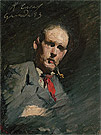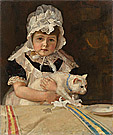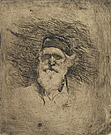Theme Portraits
‘… the subtlety of it & the way the pigments have been floated & flickered on I grasp all that the painter meant, no brush work no cleverness.’
Roberts on Velásquez’s approach to paint in his portraits,14 November 1909
Roberts was Australia’s leading portrait painter of the late nineteenth and early twentieth centuries. For many years, portraiture was a principal source of income, and 40 per cent of his oeuvre.
Roberts’ portraits include a wide range of subjects, some ‘official’ and some of friends: pastoralists, businessmen, politicians, fellow artists, musicians, actors, fashionable ladies, children, and Aboriginal people. As is the case with many portraitists, the commissions are often more impersonal and those of friends show more flair and greater empathy. Many of his portraits of women and girls also demonstrate a sensitivity to the subject.
In 1899 the contemporary critic A.G. Stevens (Titian Redde) noted that Roberts had ‘an instinct for accuracy which makes good likenesses, and an instinct of art which makes charming likenesses. The distinction that may come from the turn of a chin [as in An Australian native and Lily Stirling], or the softening of bright eyes and cheeks under a gossamer veil [as in Eileen and Portrait of Florence], or from a bare hand holding a glove, or a cunning bit of colour in the hat [as in A French hat]’.
Familiar faces and figures (1896–99)
In 1896 Robert began a sequence of twenty-three ‘Familiar faces and figures’. He hoped that this group of portraits would inspire the locals to set up a National Portrait Gallery in Australia, to follow London’s, which had opened in 1856. Whistler had commented that Velásquez made ‘his people live within their frames, and stand upon their legs’, and Roberts strove to achieve this in his series.
Leaving most of the background bare, Roberts sketched the figures onto a narrow wooden panel. In some portraits he first drew in the figure in pencil. He used the primed grain of the wooden panels to add relief to the black of the male attire. Most of the panels showed only the subject with no identifying clue, an exception being the line of music in the bottom left corner of Alfred Hill.
Roberts first exhibited this group of figures in November 1900 in Exhibition and sale of paintings by Tom Roberts, previous to his leaving Australia, at the Society of Artists’ Rooms, Pitt Street, Sydney.
Portraits of Aboriginal people
Roberts made a particular effort to depict and pay homage to Indigenous Australian people in works such as Aboriginal head, Charlie Turner and Aboriginal woman (Mariah, Yugilbar). He was the only one among his colleagues to have such an interest. These portraits were also part of his project to record people characteristic of Australian life.
In 1892 he made a journey to northern Queensland with the purpose of depicting Aboriginal and Torres Strait Islander people. He painted several portrait studies during this trip, such as Young lubra, Cape York, which show a sensibility towards his subjects that was uncommon for the time. Interested in observing the customs and dress of the people he met, Roberts also made several pen and ink and wash drawings, such as Group of six men performing a dance … on Murray Island, Torres Strait 1892.


![Tom ROBERTS | Una muchacha [A girl] | 1883](images/sml/273842.jpg)









